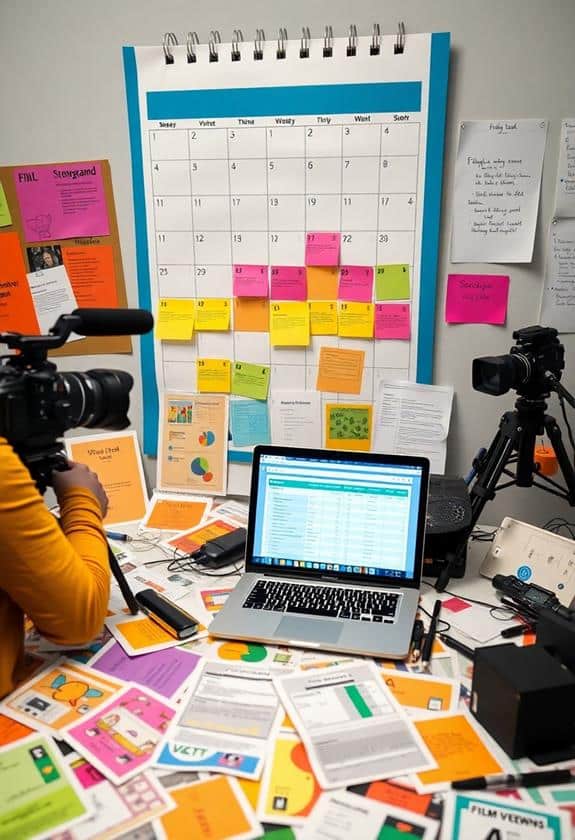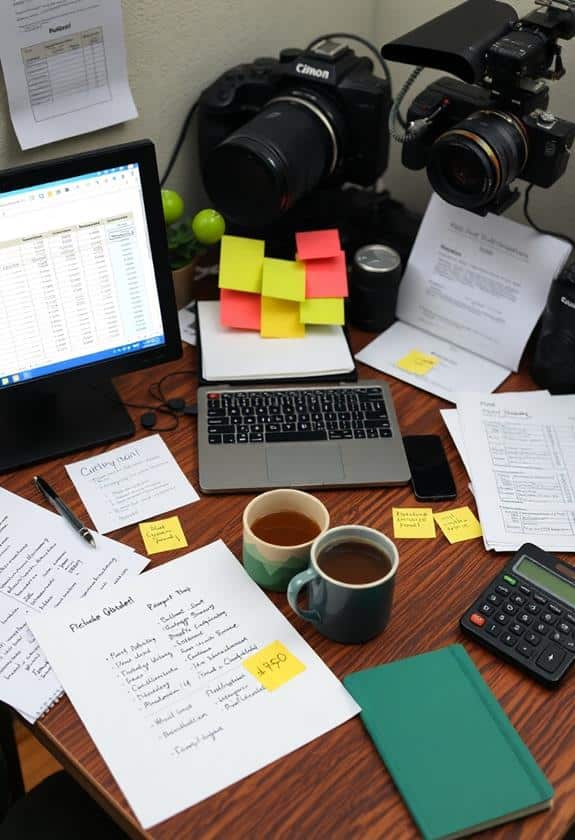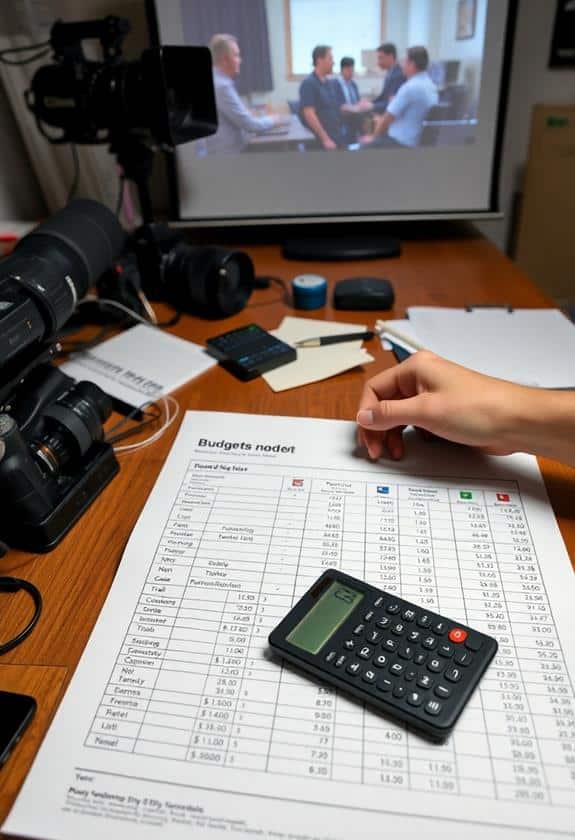Budgeting for your short film doesn’t have to feel like climbing a mountain! Start by defining your film’s scope and listing what you really need, like actors and locations. Then, research costs online or at rental shops and keep everything organized in a spreadsheet—trust me, it helps! Prioritize must-haves, find your funding sources, and don’t forget a little cushion for surprises! Track your spending and stay flexible with the budget as things change. Finally, review everything until you feel confident. It’s a journey, but soon you’ll find yourself excited about the next steps ahead!
Key Highlights
- Define your film’s scope, including story, duration, and necessary resources to guide your budgeting process.
- Research and estimate costs for all required elements, using online resources and local shops for accurate pricing.
- Break down the budget into categories (cast, crew, equipment, locations) to identify potential savings and ensure clarity.
- Prioritize essential expenses and allocate a contingency fund to prepare for unexpected costs during production.
- Track spending meticulously and adjust the budget as needed to maintain financial control throughout the project.
Define Your Film’s Scope

When budgeting for your short film, the first step is to clearly define its scope. Think of scope as the blueprint of your film—it helps you see the big picture. Start by asking yourself what story you want to tell. Is it a heartwarming tale of friendship, or a thrilling mystery? Once you know your story, consider how long it’ll be. Short films typically run anywhere from one to fifteen minutes.
Next, think about the resources you’ll need. Will you require actors, special effects, or unique locations? When I made my first short film, I got a little too ambitious and ended up in a park with a cast of twenty! Let me tell you, managing that many people was no easy feat, but it taught me the importance of planning.
Research and Estimate Costs

Diving into the budgeting process, researching, and estimating costs becomes essential for your short film’s success. You’ll want to start by making a list of all the elements your film needs. Think about locations, actors, props, and equipment, including essentials like essential filmmaking equipment that can make a difference in your production quality. Trust me, I once forgot to include snacks for the crew, and it turned into a mini-crisis!
Next, dig into the internet for price estimates. Websites like Film Riot and Indie Film Hustle can be gold mines for info. You can also reach out to local rental shops for equipment costs or even ask friends who’ve made films for their insights. Just remember, it’s okay to ask questions—people love sharing their experiences!
As you gather data, keep a spreadsheet handy. It’ll help you organize your findings and avoid those pesky surprises down the road. Estimating costs accurately will give you a solid foundation and peace of mind. Plus, it’ll help you make informed decisions, ensuring you stick to your budget. When you feel secure about your costs, you can focus more on the creative side of filmmaking, which is what it’s all about!
Break Down the Budget

Breaking down your budget is essential to keeping your filmmaking project on track. When I first started making short films, I thought I could just throw numbers together and call it a day. Let me tell you, that didn’t work out so well! Instead, take a closer look at each category, like cast, crew, equipment, and locations. This way, you can see where your money’s going and avoid any surprises down the road. Investing in affordable filmmaking gear can also help you stretch your budget further.
Start by listing all your expenses. You’ll be amazed at how much you can save when you see everything laid out. For instance, if you want to film at a local park, check if you need a permit—it might cost a bit but could save you from getting kicked out! And don’t forget about snacks; trust me, a well-fed crew works better.
Use tools like spreadsheets to keep everything organized. Color-coding categories can make it fun and easy to read. Remember, every penny counts! By breaking down your budget, you’re not just ensuring your film gets made; you’re also building a solid foundation for future projects. So grab that calculator and start breaking it down!
Prioritize Essential Expenses

After you’ve laid out your budget, it’s time to focus on what truly matters. You’ll want to prioritize essential expenses to keep your film on track and safe. Think about your must-haves: cast, crew, equipment, and locations. If you skip on these, you might end up with a film that doesn’t quite capture your vision. Investing in quality gear, like a Glide Gear BFS 100 butterfly scrim diffuser, can dramatically enhance your lighting quality without breaking the bank. For instance, I once tried to save money by cutting corners on lighting. Let me tell you, it was a disaster! Poor lighting can ruin your shots and lead to endless reshoots. So, make sure you allocate enough for quality gear that’ll keep your film looking sharp.
Next, don’t forget about safety. If you’re filming on location, a small budget for insurance can save you from huge headaches later. It’s like wearing a helmet while riding a bike—better safe than sorry!
Lastly, keep a little cushion for unexpected costs. Trust me, things will pop up. By prioritizing these essential expenses, you’ll not only safeguard your project but also give it the best chance to shine. Happy filming!
Identify Funding Sources

Securing funding is an essential step in bringing your short film to life. Without the right resources, even the best ideas can wither away. So, let’s explore some safe and reliable funding sources that can help you get started:
- Personal Savings: Dig into your own piggy bank. It might feel a bit scary, but investing in your dream can be the first step to making it a reality. Additionally, consider budgeting for high-quality equipment like audio recorders to enhance your film’s production value, as discovering top audio recorders can greatly improve your sound quality.
- Crowdfunding: Platforms like Kickstarter or Indiegogo let you share your vision with the world. You can connect with folks who believe in your project and are willing to support it. Plus, it’s a great way to build a community around your film!
- Grants and Competitions: Many organizations offer grants specifically for filmmakers. Research local film festivals or competitions where you can submit your script or concept. Winning could not only give you funds but also valuable exposure.
Track Spending and Adjust

Tracking your spending is essential for keeping your short film project on budget. You’ll want to create a simple spreadsheet or use a budgeting app to record every expense. Trust me, it’ll save you from financial headaches later. When I made my first short film, I thought I could just remember everything. Spoiler alert: I forgot a few big expenses and ended up scrambling to cover them! Additionally, investing in the right essential editing equipment can help streamline your process and avoid unexpected costs.
Make sure to categorize your spending, like equipment, actors, and locations. This way, you can see where your money goes and if you’re overspending in any area. If you notice that you’re nearing your limit in one category, don’t panic! It’s time to adjust. Maybe you can find a less expensive location or rent gear instead of buying it.
Staying organized not only helps you manage your budget but also brings you peace of mind. You’ll feel more in control and less stressed. Plus, knowing where your money is going allows you to focus on what really matters: telling your story. So keep tracking, stay flexible, and remember that every dollar counts on your filmmaking journey!
Prepare for Contingencies

Unexpected expenses can arise at any moment during your short film project, so planning for contingencies is a smart move. Trust me, I’ve been there! A sudden equipment failure or an unexpected location fee can throw your budget off track, leaving you scrambling. To help you prepare, consider these three key steps:
- Set Aside a Contingency Fund: Aim for about 10-15% of your total budget. This cushion can cover those surprise costs and keep your project on track.
- Research and Build Relationships: Get to know local vendors, rental houses, and crew members. Having reliable contacts can save you time and money when something doesn’t go as planned.
- Create a Flexible Schedule: Life happens, right? Build in extra time for shoots or reshoots, just in case. You don’t want to rush because of unexpected delays.
Review and Finalize Budget

After all the hard work you’ve put into planning your short film, it’s time to review and finalize your budget. This step is essential for ensuring your film stays on track and within financial limits. Grab a cozy spot, maybe a warm drink, and take a moment to go through your budget line by line. Verify all your expenses—equipment, locations, and crew fees. You don’t want any surprise costs sneaking up on you!
Once you’ve double-checked everything, consider your contingency fund. It’s like having a safety net; you’re glad it’s there when unexpected expenses arise. Trust me, I once forgot to account for a location permit, and it was a lesson learned the hard way!
Now, don’t hesitate to share your budget with trusted friends or mentors. They might spot something you missed or offer helpful advice. As you finalize, remember to stay flexible; sometimes, you’ll need to adjust based on feedback or unforeseen circumstances. Embrace the excitement and creativity of your project! With a well-reviewed budget, you’ll feel more secure as you commence your filmmaking journey. Happy budgeting!
Frequently Asked Questions
How Can I Determine My Film’s Target Audience for Budgeting?
To determine your film’s target audience, start by thinking about who would enjoy the story you want to tell. Consider their age, interests, and what makes them laugh or cry. You could even ask friends or family for their opinions; sometimes, they see things you don’t! Plus, check out similar films and see who liked them. Remember, understanding your audience helps you budget wisely and create something they’ll love!
What Tools Can Assist With Budgeting Short Films Effectively?
You’d think budgeting’s all about crunching numbers, right? But it’s way more creative! Tools like spreadsheets and budgeting software can make a huge difference. They help you track expenses and prioritize needs. I remember struggling to manage my film costs until I found these tools. They turned budgeting into a more manageable puzzle rather than a scary monster. So, grab some software, and you’ll see how fun budgeting can actually be!
Are There Grants Specifically Available for Short Film Projects?
Yes, there are grants specifically for short film projects! You can check out organizations like the Sundance Institute or local arts councils, which often provide funding. I remember when I applied for a grant; it felt intimidating, but the support was incredible. Just make sure you tell your unique story and showcase your passion! It’s all about connecting with your audience, even if it’s just the panel reading your proposal. Good luck!
How Do I Negotiate With Vendors for Lower Costs?
When you’re negotiating with vendors, start by building a friendly relationship. Always be honest about your budget limits; many vendors appreciate transparency. You could mention how much you love their work and ask if they can offer a discount or package deal. Sometimes, they’ll throw in extras just to keep you happy! Remember, a little charm goes a long way, and who knows? You might even get a better price than expected!
What Is the Typical Timeline for a Short Film Budget?
You’re in the thrilling world of short films, and the budget timeline can feel like a rollercoaster! Typically, you’ll want to start budgeting about four to six weeks before filming. This gives you time to research costs, negotiate with vendors, and plan for unexpected expenses. I once underestimated costs and learned the hard way! So, stay organized, keep your notes handy, and don’t forget to have fun along the way!
Conclusion
Budgeting for your short film can feel like climbing a mountain, but remember, even the tallest peaks are made of small steps. By clearly defining your film’s scope and keeping track of every dollar, you’ll not only prepare for the unexpected but also find joy in the process. So, don’t shy away from the challenge—embrace it! Filmmaking is your passion, and with a solid budget, you’ll turn your creative dreams into a reality. Happy filming!




